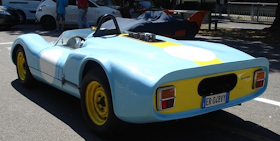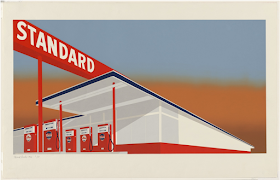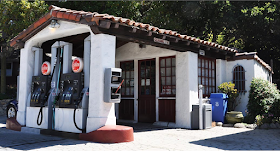You may be wondering why we need to expand our history of Giannini cars and engines to include something called the Giaur, and who Urania and Taraschi were. Well, you couldn't do a very good job of tracing the history of Martha and the Vandellas, for example, if you just concentrated on Martha, so we'll begin with some of what Hollywood calls "back story". Brothers Attilio and Domenico Giannini got into tuning cars for racing early, first with Italas in 1920 and then Fiats in the 1930s. Bernardo Taraschi began building Urania ("heavenly") racers with BMW motorcycle engines after World War II (possibly using engines from abandoned German army motorcycles), but the search for more power led to his partnership with the Giannini brothers, who had begun modifying Fiat 500 engines, then developed their single overhead cam G1. The photo below shows a BMW-powered, cycle-fendered Urania racer from the late Forties...
One thing led to another, and eventually they were making an all-Giannini G2 engine with aluminum block and twin overhead cams. By the dawn of the Fifties the Giannini-Taraschi partnership was using this engine in Giaur (GIAnnini + URania) cars and Taraschi cars, and later supplied engines to other makers, including Nardi* for the Bisiluro* ("twin torpedo") designed by architect Carlo Mollino* for the 1955 Le Mans. Here the engine is seen installed in the pod opposite the driver's side of the car. The idea was to balance the weight of driver and engine around the longitudinal centerline of the car...
Confusingly, and also because this was Italy, the Giaur combine kept on making Taraschis as well, but now with the same Giannini G2 engine, an example being the Taraschi Sport 750 from 1956 shown below. It featured a tubular chassis overlaid with alloy bodywork built by Taraschi...
One thing led to another, and eventually they were making an all-Giannini G2 engine with aluminum block and twin overhead cams. By the dawn of the Fifties the Giannini-Taraschi partnership was using this engine in Giaur (GIAnnini + URania) cars and Taraschi cars, and later supplied engines to other makers, including Nardi* for the Bisiluro* ("twin torpedo") designed by architect Carlo Mollino* for the 1955 Le Mans. Here the engine is seen installed in the pod opposite the driver's side of the car. The idea was to balance the weight of driver and engine around the longitudinal centerline of the car...
Confusingly, and also because this was Italy, the Giaur combine kept on making Taraschis as well, but now with the same Giannini G2 engine, an example being the Taraschi Sport 750 from 1956 shown below. It featured a tubular chassis overlaid with alloy bodywork built by Taraschi...
The combine produced a few closed GT cars like the handsome Giaur 750 San Remo Berlinetta shown below, bodied by Rocco Motto* in 1953. It's a rare example with full road equipment, including tidy bumpers. The proportions, contours and details deftly conceal the tiny size. Production numbers for the Motto body are lost to history, but are bound to be low...
More typical cars featuring the Giannini power plant included the Giaur 750 Record from 1954-'55. The first photo shows the car with wind-cheating spats over the wheels...
The Giaur 750 is featured in the Museo Giannini, and is shown below without its wheel spats. Overall form is similar to the Taraschi Sport 750 which appeared a year or so later. As with the San Remo Berlinetta, careful handling of proportions conceals the small size of the car, and details like the air intake and trailing edge of the front wheel opening, which are curved in section as well as elevation, impart a sense of mass unlike the fragility sometimes conveyed by road-racing etceterini...
Outside the limited-production series of Giaur and Taraschi road racers using their own G2 engine, Giannini also offered some tamer cars with lightly modified Fiat pushrod engines during this period. One example is the 1100TV* Fiat Boano Giannini featured below in an ad for Carrozzeria Boano, which designed and built the body in 1956...
In the late Fifties, Formula Junior, restricted to mass-produced engines of no more than 1,100 cubic centimeters, became the favored entry-level racing series for open-wheel, single-seat road racers. Bernardo Taraschi entered the field with this front-engined design with Fiat power. It achieved success on the track and in the marketplace, and Taraschi would eventually build 63 of these Juniors, with 13 going to the United States, making it the most popular single design produced by this group. The year after the 1960 Taraschi shown below was built, the original Giannini partnership broke up, with Attilio founding Costruzioni Meccaniche Giannini, which would concentrate on designing and building prototypes, including engineering for racing engines. Giannini Automobili split off to run the repair facilities and retail outlets.
Probably the rarest product of the Giannini Meccaniche operation, and of all Giannini-engined cars, is the V8 produced in 1967. There seems to be no technical information published on the car or engine, not even on the Giannini website, and for awhile it seemed to be the Italian equivalent of cartoonist Bruce McCall's French exotic "La Vume" (voom), "a car so exclusive that none will ever be built." But these photos of a blue and yellow road racer surfaced recently, and they prove that Giannini, like Abarth* and Bandini*, stayed in the etceterini business long enough to join the mid-engine revolution...
Below is a shot of that engine. As we have not found any specifications, it's not clear whether it was developed from two Giannini twin-cam fours on a common crankcase, or was a completely new design. The displacement was under two liters. There are enough visual differences from small V8s by other Italian makes (Abarth, Alfa Romeo, ATS) to confirm it doesn't borrow from them. So tooling cost per unit produced must have been high indeed...
Fiberglass bodywork showed some similarity to the contemporary Porsche 906 in the shape of the nose and headlight covers, as well as in the placement of the rear fender air intakes and the use of plain, bolt-on wheels...
The design of the tail also echoes contemporary road racer practice, with the turned-up spoiler for added downforce; the license plate may indicate that the car was driven on public roads at some point, maybe to the races...
The financial strain of designing and fabricating race cars like this V8 led to the closing of Attilio's Giannini Meccaniche operation in 1971. Giannini Automobili continued to offer lightly modified Fiat production cars. This aspect of the family business continued into the Eighties, but not without one more effort at making a GT car based upon production components. Partnering with coach builder Francis Lombardi* in early 1968, Franco Giannini, son of Domenico, offered a sleek, low two-seater coupe based upon Fiat 850 floor pans and power trains. The Giannini family formed a joint venture with Lombardi called OTAS (Officina Trasformazioni Automobili Sportive) to make cars for the European and American markets. The rear-mounted pushrod fours were offered in sizes up to 1,000cc in the Giannini Grand Prix for Italian consumption, while the OTAS cars exported to the US featured an 817cc engine to avoid emissions regulations. Abarth offered a 1,300cc pushrod engine in its Scorpione, and a few of these were imported into the US by California dealer Rich Motors in Southern California. The car shown below is a 1971 OTAS from the Lane Motor Museum in Nashville, Tennessee. The Lombardi-bodied coupes are likely the best known and most frequently seen descendants of the Giannini car family in the USA. A registry produced by a Lombardi GP owner in 2015 indicated 140 surviving cars of several hundred built. The earlier cars with Giannini-designed G1 and G2 racing engines, and their Urania relatives, are rarer, with 14 Uranias, 48 Giaur and Taraschi sports cars, and 63 Taraschi Formula Juniors, for a total of 125 cars confirmed by the partners.
Since those days, Giannini has been linked closely to Fiat, offering small modifications to regular production cars. Recently, though, Giannini Automobili has offered something a bit wilder to celebrate the upcoming 100th anniversary of their founding. This is the Giannini 350GP, with a 1.7 liter turbocharged inline 4 from the Alfa Romeo 4C, mid-mounted as in the Alfa, and driving the rear wheels. The whole ensemble is tucked under a highly modified modern Fiat 500 body, with wide fenders to clear the wheels required to handle the 350 horsepower. If you live in Europe, you can reconnect with the Giannini tradition for a mere 130,000 Euros...
*Footnote: In the 21-part (so far) Etceterini Files, we have featured many close relatives of the Giannani and Taraschi cars. Here's a brief index:
Nardi Bisiluro: "Architect Designed Cars Part 1", May 7, 2017
Nardi history: "Etceterini Files Part 14----Enrico Nardi and His Cars: Present at the Creation", Feb. 26, 2018
Rocco Motto: "Unsung Genius: Rocco Mottos, the Closer", March 25, 2018
Fiat 1100TV: "Etceterini Files Part 9----Plain Old Fiats Plus: 1100TV & 1200TV", Sept. 29, 2016
Francis Lombardi: "Etceterini Files Part 15", Oct. 26, 2018
Abarth: "Etceterini Files Part 13", Jan. 15, 2018
Bandini, "Etceterini Files Part 8---Bandini, the Art of Endurance", Sept. 18, 2016
Nardi Bisiluro: "Architect Designed Cars Part 1", May 7, 2017
Nardi history: "Etceterini Files Part 14----Enrico Nardi and His Cars: Present at the Creation", Feb. 26, 2018
Rocco Motto: "Unsung Genius: Rocco Mottos, the Closer", March 25, 2018
Fiat 1100TV: "Etceterini Files Part 9----Plain Old Fiats Plus: 1100TV & 1200TV", Sept. 29, 2016
Francis Lombardi: "Etceterini Files Part 15", Oct. 26, 2018
Abarth: "Etceterini Files Part 13", Jan. 15, 2018
Bandini, "Etceterini Files Part 8---Bandini, the Art of Endurance", Sept. 18, 2016
Photo Credits:
Top: pinterest.com
2nd: dannatavintage.com
3rd & 4th: squadrataraschi.it
5th: Giannini Automobili
6th: automoto.it
7th: Carrozzeria Boano on classicvirus.com
8th: AutoMania.it
9th, 11th & 12th: forum-auto.caradisiac.com
10th: retrovisiones.com
13th: lanemotormuseum.org
14th: Giannini Automobili
Top: pinterest.com
2nd: dannatavintage.com
3rd & 4th: squadrataraschi.it
5th: Giannini Automobili
6th: automoto.it
7th: Carrozzeria Boano on classicvirus.com
8th: AutoMania.it
9th, 11th & 12th: forum-auto.caradisiac.com
10th: retrovisiones.com
13th: lanemotormuseum.org
14th: Giannini Automobili









































